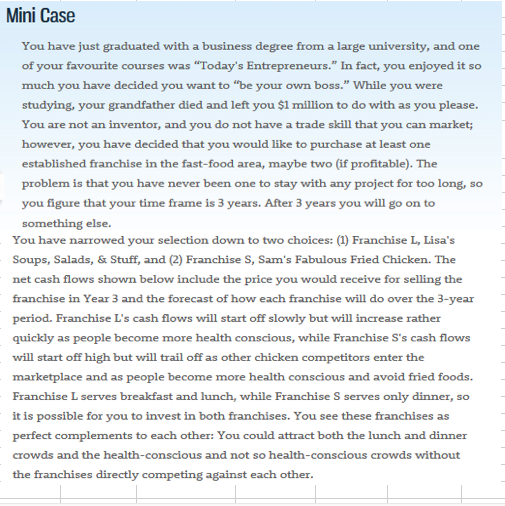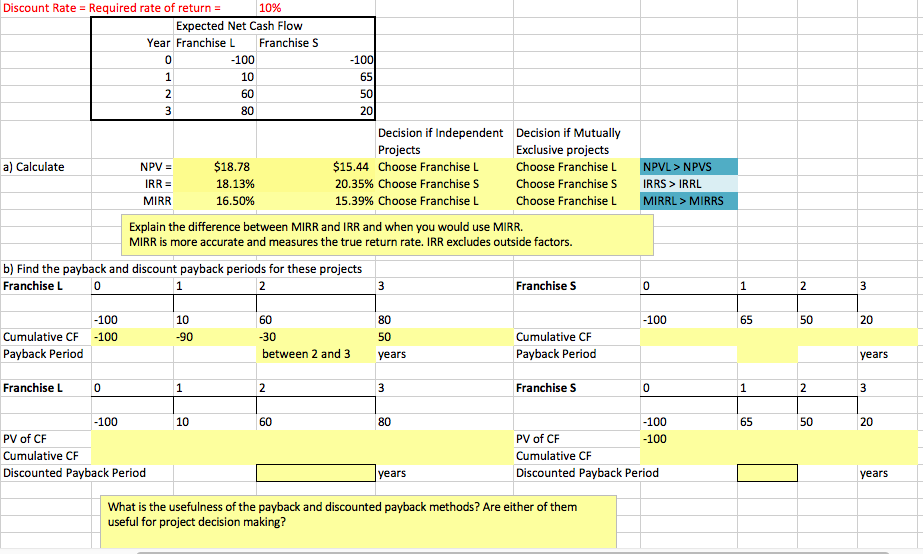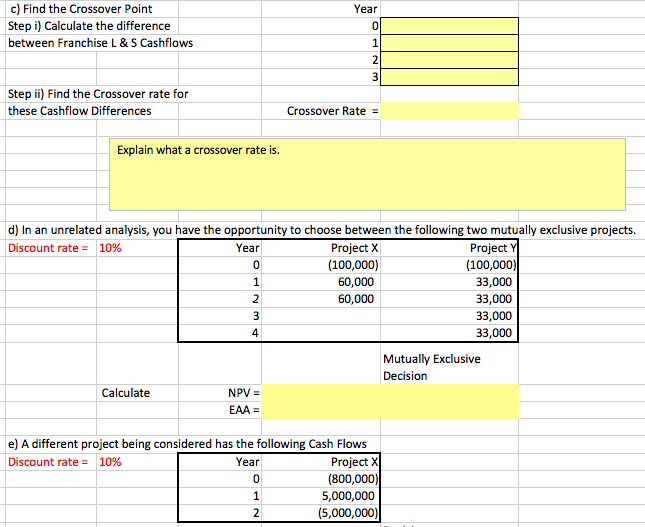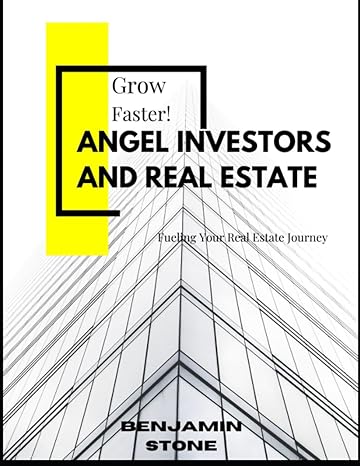Answered step by step
Verified Expert Solution
Question
1 Approved Answer
Am I on the right track? Mini Case You have just graduated with a business degree from a large university, and one of your favourite




Am I on the right track?
Mini Case You have just graduated with a business degree from a large university, and one of your favourite courses was "Today's Entrepreneurs." In fact, you enjoyed it so much you have decided you want to "be your own boss." While you were studying, your grandfather died and left you $1 million to do with as you please. You are not an inventor, and you do not have a trade skill that you can market; however, you have decided that you would like to purchase at least one established franchise in the fast-food area, maybe two (if profitable). The problem is that you have never been one to stay with any project for too long,so you figure that your time frame is 3 years. After 3 years you will go on to something else. You have narrowed your selection down to two choices: (1) Franchise L, Lisa's Soups, Salads, & Stuff, and (2) Franchise S, Sam's Fabulous Fried Chicken. The net cash flows shown below include the price you would receive for selling the franchise in Year 3 and the forecast of how each franchise will do over the 3-year period. Franchise L's cash flows will start off slowly but will increase rather quickly as people become more health conscious, while Franchise S's cash flows will start off high but will trail off as other chicken competitors enter the marketplace and as people become more health conscious and avoid fried foods. Franchise L serves breakfast and lunch, while Franchise S serves only dinner, so it is possible for you to invest in both franchises. You see these franchises as to each other: You crowds and the health-conscious and not so health-conscious crowds without the franchises directly competing against each other. Discount Rate Required rate of return- 1096 Expected Net Cash Flow Year Franchise L Franchise S 100 10 0 65 Decision if Independent Projects Decision if Mutually Exclusive projects $18.78 18.13% 16.50% $15.44 Choose Franchise L Choose Franchise L NPVL > NPVS 20.35% Choose Franchises 15.39% Choose Franchise L a) Calculate IRR- MIRR Choose Franchise S Choose Franchise L IRRS> IRRL IRRL> MIRRS Explain the difference between MIRR and IRR and when you would use MIRR. MIRR is more accurate and measures the true return rate. IRR excludes outside factors. b) Find the payback and discount payback periods for these projects Franchise L Franchise S 100 10 100 65 50 20 Cumulative CF -100 50 Cumulative CF Payback Period between 2 and 3 years Payback Period years Franchise L Franchise S 100 100 100 10 65 50 20 PV of CF Cumulative CF Discounted Payback Period PV of CF Cumulative CF Discounted Payback Period years years What is the usefulness of the payback and discounted payback methods? Are either of them useful for project decision making? c) Find the Crossover Point Step i) Calculate the difference between Franchise L& S Cashflows Year Step i) Find the Crossover rate for these Cashflow Differences Crossover Rate- Explain what a crossover rate is. d) In an unrelated analysis, you have the opportunity to choose between the following two mutually exclusive projects. Discount rate-10% Project X (100,000) 60,000 60,000 Project Y (100,000) 33,000 33,000 33,000 33,000 Year 0 4 Mutually Exclusive Decision Calculate EAA e) A different project being considered has the following Cash Flows Discount rate-10% Project X (800,000) 5,000,000 (5,000,000) Year 0 Decision Explain why the decisions are contradictory, and explain which technique you should trust. Mini Case You have just graduated with a business degree from a large university, and one of your favourite courses was "Today's Entrepreneurs." In fact, you enjoyed it so much you have decided you want to "be your own boss." While you were studying, your grandfather died and left you $1 million to do with as you please. You are not an inventor, and you do not have a trade skill that you can market; however, you have decided that you would like to purchase at least one established franchise in the fast-food area, maybe two (if profitable). The problem is that you have never been one to stay with any project for too long,so you figure that your time frame is 3 years. After 3 years you will go on to something else. You have narrowed your selection down to two choices: (1) Franchise L, Lisa's Soups, Salads, & Stuff, and (2) Franchise S, Sam's Fabulous Fried Chicken. The net cash flows shown below include the price you would receive for selling the franchise in Year 3 and the forecast of how each franchise will do over the 3-year period. Franchise L's cash flows will start off slowly but will increase rather quickly as people become more health conscious, while Franchise S's cash flows will start off high but will trail off as other chicken competitors enter the marketplace and as people become more health conscious and avoid fried foods. Franchise L serves breakfast and lunch, while Franchise S serves only dinner, so it is possible for you to invest in both franchises. You see these franchises as to each other: You crowds and the health-conscious and not so health-conscious crowds without the franchises directly competing against each other. Discount Rate Required rate of return- 1096 Expected Net Cash Flow Year Franchise L Franchise S 100 10 0 65 Decision if Independent Projects Decision if Mutually Exclusive projects $18.78 18.13% 16.50% $15.44 Choose Franchise L Choose Franchise L NPVL > NPVS 20.35% Choose Franchises 15.39% Choose Franchise L a) Calculate IRR- MIRR Choose Franchise S Choose Franchise L IRRS> IRRL IRRL> MIRRS Explain the difference between MIRR and IRR and when you would use MIRR. MIRR is more accurate and measures the true return rate. IRR excludes outside factors. b) Find the payback and discount payback periods for these projects Franchise L Franchise S 100 10 100 65 50 20 Cumulative CF -100 50 Cumulative CF Payback Period between 2 and 3 years Payback Period years Franchise L Franchise S 100 100 100 10 65 50 20 PV of CF Cumulative CF Discounted Payback Period PV of CF Cumulative CF Discounted Payback Period years years What is the usefulness of the payback and discounted payback methods? Are either of them useful for project decision making? c) Find the Crossover Point Step i) Calculate the difference between Franchise L& S Cashflows Year Step i) Find the Crossover rate for these Cashflow Differences Crossover Rate- Explain what a crossover rate is. d) In an unrelated analysis, you have the opportunity to choose between the following two mutually exclusive projects. Discount rate-10% Project X (100,000) 60,000 60,000 Project Y (100,000) 33,000 33,000 33,000 33,000 Year 0 4 Mutually Exclusive Decision Calculate EAA e) A different project being considered has the following Cash Flows Discount rate-10% Project X (800,000) 5,000,000 (5,000,000) Year 0 Decision Explain why the decisions are contradictory, and explain which technique you should trustStep by Step Solution
There are 3 Steps involved in it
Step: 1

Get Instant Access to Expert-Tailored Solutions
See step-by-step solutions with expert insights and AI powered tools for academic success
Step: 2

Step: 3

Ace Your Homework with AI
Get the answers you need in no time with our AI-driven, step-by-step assistance
Get Started


